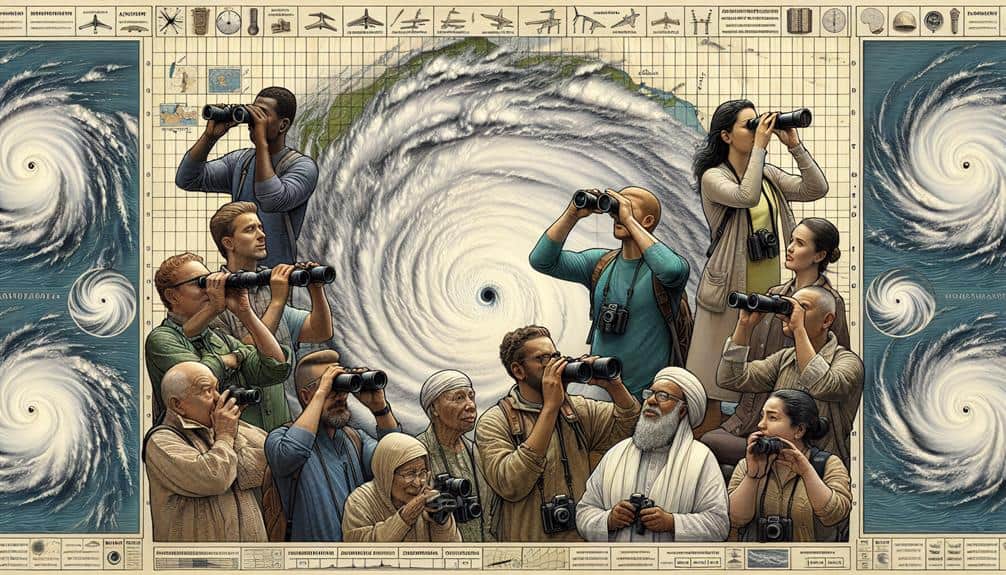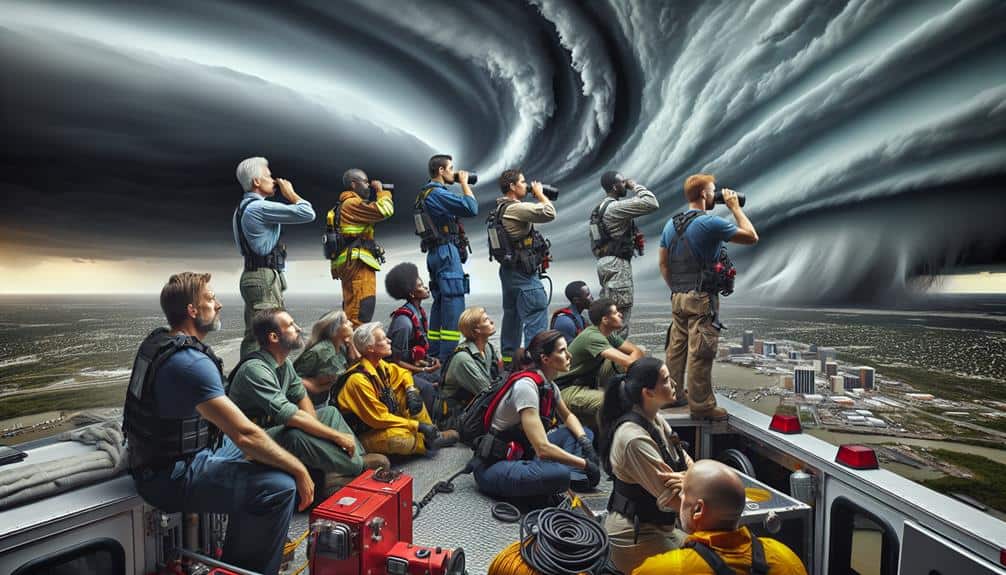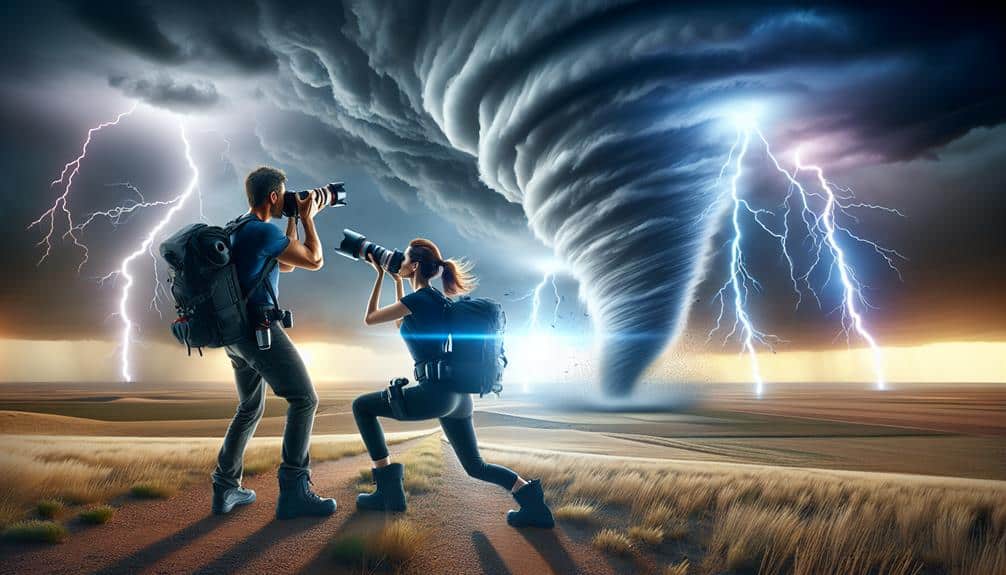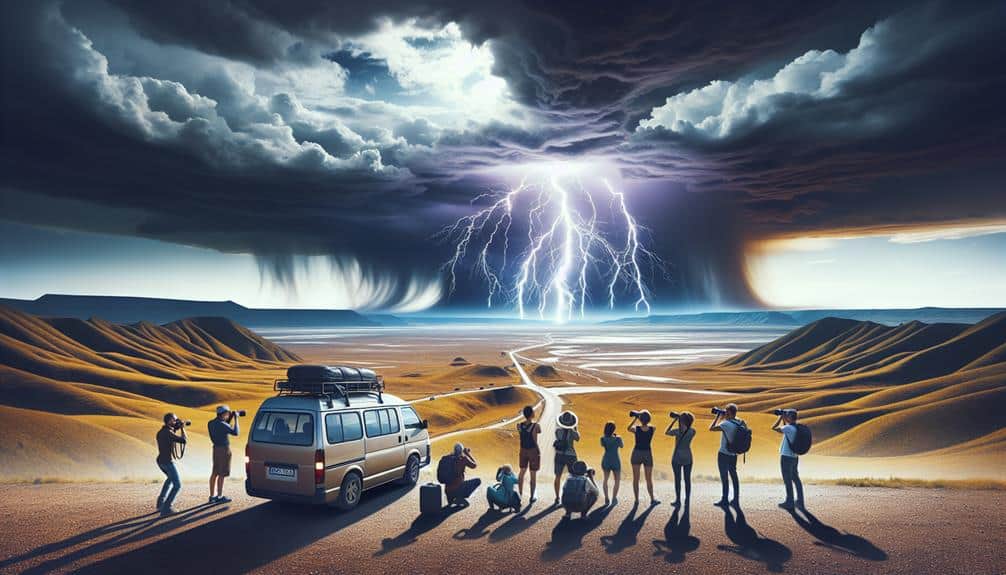Joining guided tours for chasing hurricanes guarantees we prioritize safety with real-time data and advanced meteorological tools. We gain access to Doppler radar systems, satellite imaging, and high-resolution cameras, providing precise tracking and analysis. Expert meteorologists guide us, ensuring thorough safety protocols and invaluable educational opportunities. Networking with fellow enthusiasts fosters community and data exchange. Our tours include dynamic weather updates and strict emergency procedures. This approach allows us to enjoy responsible storm chasing while deepening our understanding of hurricane dynamics. Exploring these opportunities further reveals the full breadth of this exhilarating experience.
Key Points
- Access expert guidance and advanced meteorological tools for enhanced safety and learning.
- Benefit from real-time weather updates and immediate storm tracking for dynamic route adjustments.
- Utilize high-resolution imaging devices for detailed storm analysis and valuable data collection.
- Engage in responsible storm chasing practices to minimize environmental impact and ensure community outreach.
Expert Guidance and Safety
With expert guidance, we prioritize safety by leveraging real-time data and advanced meteorological tools to navigate the volatile conditions of hurricanes. Our commitment to safety begins with strict safety protocols designed to protect everyone in the group. By understanding the intricacies of group dynamics, we guarantee each member knows their role and responsibilities during the expedition.
Our weather knowledge is grounded in the latest scientific research and real-time updates, allowing us to predict and react to rapidly changing conditions. This expertise is crucial for making informed decisions on the ground. We use a suite of advanced meteorological tools to monitor storm patterns, wind speeds, and potential hazards, ensuring we're always one step ahead of the storm.
Emergency procedures are drilled into the team, guaranteeing that everyone knows what to do should conditions deteriorate unexpectedly. From evacuation plans to first-aid protocols, we leave nothing to chance. Each member is briefed on these procedures, reinforcing a sense of preparedness and self-reliance.
Access to Advanced Equipment
We provide participants with specialized meteorological tools, including Doppler radar systems and anemometers, to monitor storm conditions accurately.
Our high-resolution imaging devices capture detailed visuals, enabling real-time analysis and data collection.
These advanced instruments not only enhance the educational experience but also guarantee precise tracking and safety during the tours.
Specialized Meteorological Tools
Access to specialized meteorological tools, such as Doppler radar systems and satellite imaging technology, allows us to accurately track and analyze hurricanes in real-time. These advanced technologies provide unparalleled precision in storm tracking, enabling us to predict hurricane paths and intensities with greater reliability. Through meticulous data analysis, we can interpret a wealth of meteorological data, enhancing our understanding of these formidable natural phenomena.
In guided tours, we benefit from the latest technology advancements in meteorological research. Doppler radar systems, for example, measure wind speed and precipitation within the storm, offering critical insights into a hurricane's structure and potential impact zones. Satellite imaging provides a macro perspective, capturing real-time visuals of storm development from space. This dual approach enriches our data pool, facilitating more robust and detailed analyses.
High-Resolution Imaging Devices
High-definition imaging devices, like ultra-HD cameras and advanced spectrometers, capture intricate details of hurricane dynamics, providing vital data for precise storm analysis. When we're out in the field, these tools enable us to engage in remote sensing, allowing us to monitor and record the storm's progression without direct physical proximity. The high-definition imagery and spectral data we gather are invaluable for improving weather forecasting models.
Remote sensing technology offers us a bird's-eye view, revealing the structure and development of the hurricane in real-time. Ultra-HD cameras provide clear, detailed visual data, while advanced spectrometers capture a wide range of wavelengths, offering insights into the storm's intensity and composition. This multi-faceted approach ensures that we collect inclusive data, which is essential for making accurate predictions and timely warnings.
Educational Opportunities

By participating in hurricane-chasing guided tours, individuals gain access to real-time meteorological data and firsthand learning experiences that traditional classroom settings can't replicate. These tours offer unique hands-on learning and interactive experiences that are invaluable for anyone passionate about meteorology.
During these expeditions, we engage in field research and data collection that provide us with a deeper understanding of hurricane dynamics. We use state-of-the-art instruments to measure wind speeds, pressure changes, and precipitation rates. This real-time data collection allows us to analyze the evolving structure of hurricanes, enhancing our predictive models and contributing to scientific research.
Moreover, we benefit from the expertise of professional meteorologists who guide these tours. Their real-world insights and data-driven analyses offer an extensive educational experience that goes beyond textbooks. We also participate in interactive experiences like deploying sensors and interpreting satellite imagery, which helps us grasp the complexities of storm systems.
In essence, these guided tours serve as a mobile classroom where we can immerse ourselves in the science of hurricanes. This approach not only satisfies our quest for knowledge but also empowers us with the freedom to explore and understand nature's most powerful phenomena.
Networking With Enthusiasts
Joining hurricane-chasing guided tours allows us to connect with other enthusiasts who share our passion for meteorology and data-driven research. These tours foster a strong community connection by bringing together individuals who are equally captivated by the intricate patterns and behaviors of hurricanes. Engaging with like-minded individuals enhances our collective understanding, as we exchange valuable insights and data.
Our shared passion for studying these natural phenomena creates an environment ripe for new friendships. We find ourselves surrounded by peers who not only grasp our interests but also contribute diverse perspectives and expertise. This mutual interest forms the foundation for lasting relationships, built on the excitement of shared discoveries and collaborative learning.
Moreover, the data-driven nature of these tours ensures that our interactions aren't just social but also intellectually stimulating. By discussing the latest research, analyzing real-time data, and sharing observational techniques, we elevate our own knowledge and contribute to the broader meteorological community. The connections we make here aren't fleeting; they offer ongoing opportunities for collaboration, whether in future hurricane chases or other meteorological ventures.
Essentially, these guided tours are a catalyst for building a robust network of passionate, knowledgeable hurricane enthusiasts.
Unique Travel Experience

Setting out on hurricane-chasing guided tours not only fosters a strong community of enthusiasts but also offers a unique travel experience characterized by the thrill of witnessing nature's most powerful phenomena up close.
These tours present an unparalleled adrenaline rush, giving us a front-row seat to the raw energy of hurricanes. The sheer force and unpredictability of these storms create an environment where we experience the intensity of weather systems firsthand.
From a technical perspective, hurricane-chasing tours offer significant hands-on learning opportunities. We gather real-time data, utilize meteorological instruments, and analyze storm patterns, all of which contribute to our understanding of these natural events. This analytical approach not only enhances our knowledge but also provides us with practical skills that can be applied in various scientific and educational fields.
Moreover, these tours often involve cultural immersion, as we travel through different regions affected by hurricanes. We interact with local communities, understand their resilience, and witness the impact of these storms on their daily lives. This fosters community bonding among participants, as we share these profound experiences together.
The combination of technical learning, thrilling experiences, and cultural insights makes hurricane-chasing guided tours a unique and enriching adventure.
Real-Time Weather Updates
We rely on advanced technology to provide real-time weather updates that are essential for hurricane chasing.
With immediate storm tracking, we can adjust our routes dynamically, ensuring both excitement and safety.
Live safety alerts and accurate weather predictions enable us to make data-driven decisions on the fly.
Immediate Storm Tracking
During a hurricane chase, staying updated with real-time weather data is essential for guaranteeing both safety and accurate tracking of the storm's path. We depend on advanced tracking techniques to monitor the storm's progression minute-by-minute. Utilizing satellite imagery, Doppler radar, and reconnaissance aircraft data, we gain a thorough view of the hurricane's intensity and trajectory. This multi-faceted approach enhances storm safety by allowing us to anticipate potential hazards and adjust our position accordingly.
Real-time updates are pivotal for making informed decisions. High-frequency data feeds from NOAA and other meteorological agencies provide us with the latest information on wind speeds, atmospheric pressure, and precipitation levels. These updates enable us to refine our tracking techniques and maintain a safe distance from the storm's most hazardous zones. In the event of sudden changes, our emergency response protocols guarantee that we can quickly relocate to a safer area.
Our commitment to precision and safety doesn't restrict our freedom; rather, it empowers us to experience the raw power of nature responsibly. Through continuous monitoring and data-driven strategies, we maximize both our safety and our ability to witness these awe-inspiring phenomena up close.
Live Safety Alerts
Live safety alerts provide us with critical, real-time weather updates that are indispensable for effective hurricane chasing. By integrating these alerts into our operations, we can optimize our emergency protocols and communication strategies to keep everyone informed and safe. Real-time updates are a game-changer in managing the dynamic and unpredictable nature of hurricanes.
Our approach includes:
- Emergency Protocols: We establish clear, predefined actions to take when specific alerts are received, ensuring a swift and organized response.
- Communication Strategies: Utilizing various communication channels like radios, mobile apps, and satellite phones to disseminate alerts instantly, guaranteeing that everyone remains in the loop.
- Risk Assessment: Analyzing real-time weather data to continually evaluate the risk level, allowing us to make informed decisions about our positioning and actions.
- Evacuation Plans: Updating and executing evacuation plans based on the latest safety alerts, ensuring we can quickly relocate if the situation deteriorates.
Accurate Weather Predictions
Accurate weather predictions are crucial for hurricane chasing, supplying us with the real-time data needed to anticipate storm paths and make timely decisions. By integrating advanced weather forecasting models and satellite imagery, we gain the critical insight necessary for effective storm tracking. These technologies enable us to pinpoint the hurricane's location, intensity, and potential trajectory with remarkable precision.
We rely on sophisticated algorithms that continuously process vast amounts of atmospheric data. This includes wind speed, pressure patterns, and ocean surface temperatures. With these tools, we can interpret shifting weather patterns and predict the hurricane's evolution in real-time. This analytical approach ensures that we remain informed and ready to act on the latest updates.
Freedom in hurricane chasing stems from our ability to navigate unpredictable conditions with confidence. Real-time weather updates empower us to make informed choices, whether it's adjusting our route or finding safer vantage points.
The fusion of data-driven storm tracking and weather forecasting not only enhances our understanding of these powerful natural phenomena but also maximizes our safety and experience. Essentially, accurate weather predictions are the backbone of our hurricane-chasing endeavors, providing both the information and the freedom to explore the storm's fury.
Responsible Storm Chasing Practices

To guarantee safety and gather accurate data, we must adhere to specific protocols and guidelines while engaging in storm chasing activities. Responsible storm chasing isn't just about the thrill; it's about minimizing our environmental impact and ensuring effective community outreach.
By following a structured approach, we can contribute valuable insights without adding to the chaos.
Our best practices include:
- Environmental Impact: We should always avoid disturbing natural habitats and assure our activities don't result in additional pollution or waste. Keeping a low footprint is essential.
- Community Outreach: Engaging with local communities helps us disseminate critical information and gather local insights. This exchange improves both our data and the community's preparedness.
- Risk Mitigation: Using advanced forecasting tools and real-time data, we can effectively assess risks and make informed decisions. This minimizes potential harm to ourselves and others.
- Emergency Response: Being prepared for emergencies is non-negotiable. We must have a solid plan that includes first aid, communication protocols, and quick evacuation routes.
Frequently Asked Questions
How Do I Prepare Physically and Mentally for a Hurricane Chasing Tour?
Preparing for a hurricane chasing tour is like gearing up for a marathon. We focus on physical training to build stamina and mental preparation to stay calm under pressure. Data-driven strategies and analytical thinking guarantee we're ready for anything.
What Type of Clothing Should I Pack for a Hurricane Chase?
When packing essentials, we should focus on weather appropriate clothing such as waterproof jackets, moisture-wicking layers, durable boots, and gloves. Data shows these items guarantee maximum comfort and safety in unpredictable hurricane conditions, maximizing our freedom to explore.
Are There Any Age Restrictions for Joining a Hurricane Chasing Tour?
Imagine a storm as a wild beast; we must respect it. Health requirements and safety precautions demand parental consent for minors and caution for elderly participants. Ensuring everyone's safety is our top priority in this thrilling adventure.
How Long Do Hurricane Chasing Tours Typically Last?
Hurricane chasing tour duration varies, typically lasting 5-10 days. Our itinerary includes thorough safety precautions and emergency procedures. This guarantees we balance the thrill of chasing storms with the highest standards of safety and preparedness.
What Are the Costs Involved in Joining a Guided Hurricane Chasing Tour?
We should analyze the tour expenses, including transportation, accommodation, and meals. Typically, costs range from $2,500 to $5,000 per person, depending on the duration, services provided, and the specific tour package chosen.


